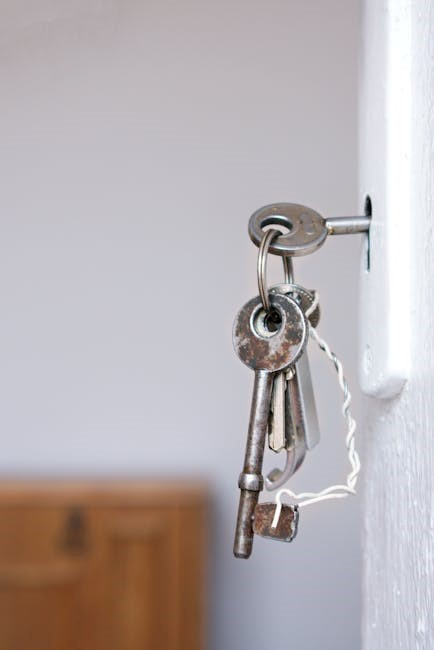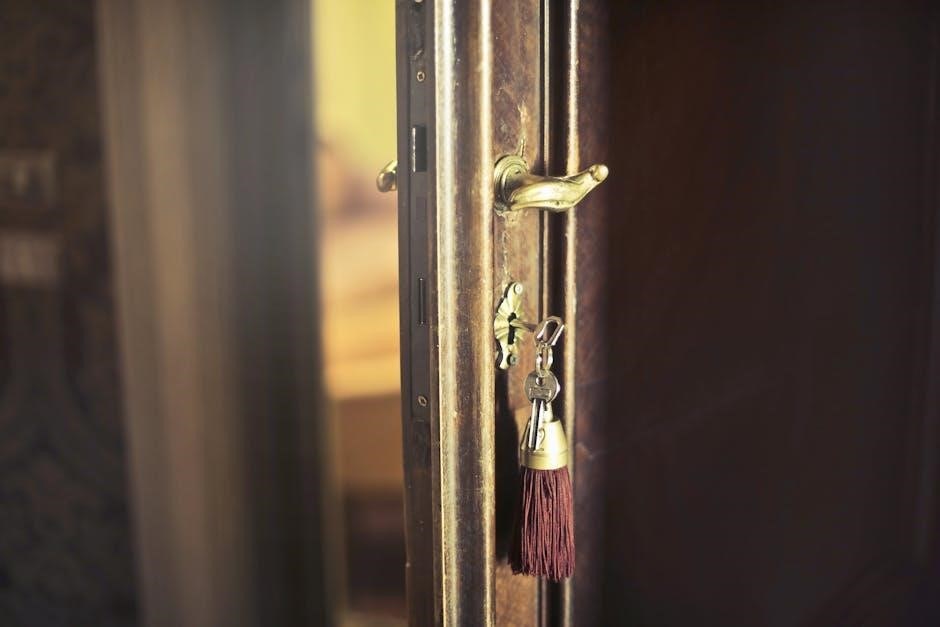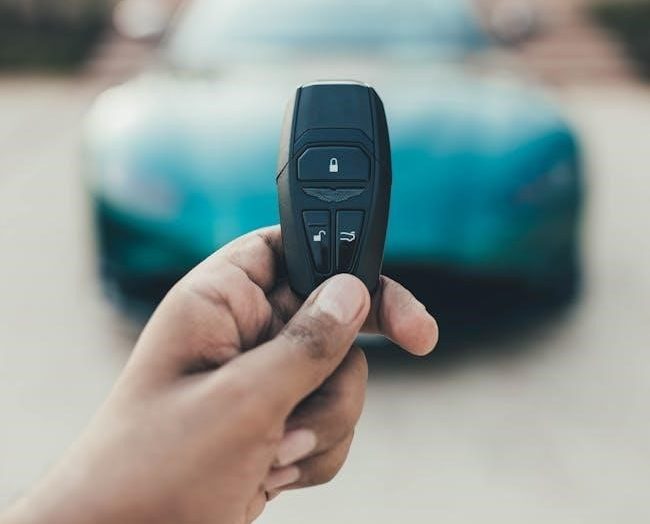Key Inspection
Inspecting the key is the first step when a manual key fails to unlock the car door, especially with a dead battery. A worn-out key is a common issue, as the teeth may no longer align with the lock’s tumblers. Check for visible signs of wear or damage. If the key is bent or corroded, it may not function properly. Additionally, a dirty or contaminated keyhole can prevent the key from turning. Try cleaning the keyhole with a soft cloth or compressed air. If the key is damaged, use a spare key if available. Applying a small amount of lubricant, like WD-40, to the key and keyhole can also help resolve sticking issues. Regular key maintenance can prevent such problems in the future.

Lock Mechanism
The lock mechanism is a critical component when dealing with a manual key that won’t unlock the car door, especially when the battery is dead. Understanding how the lock works can provide insights into why the key might be failing to function. The lock mechanism typically consists of a cylinder with internal components called tumblers. These tumblers must align correctly for the key to turn and unlock the door. If the key is worn or damaged, it may not properly align the tumblers, preventing the lock from opening. Additionally, a lack of regular maintenance can lead to corrosion or rust within the lock cylinder, causing it to become stiff or stuck.
Another common issue is contamination within the keyhole. Dust, dirt, or debris can accumulate over time, preventing the key from fitting properly or turning smoothly. Cleaning the keyhole with a soft cloth or compressed air can often resolve this problem. Lubrication also plays a role in maintaining the lock’s functionality. Applying a small amount of silicone-based lubricant or WD-40 to the keyhole can help loosen stuck parts and ensure smooth operation. However, it’s important to avoid using excessive lubricant, as it can attract more dirt and cause further issues down the line.
In some cases, the lock cylinder itself may be damaged or broken. If the key turns but the door won’t unlock, it could indicate a problem with the internal mechanism. This might require the assistance of a professional locksmith or mechanic, who can diagnose and repair or replace the faulty components. Regular maintenance, such as cleaning and lubricating the lock, can help prevent these issues from arising in the first place. By addressing the lock mechanism proactively, you can ensure that your manual key continues to function reliably, even in situations where the car’s battery is dead;

Lubrication
Lubrication is a crucial step in addressing the issue of a manual key not unlocking the car door, especially when the battery is dead. Over time, the lock mechanism can become stiff or stuck due to dirt, grime, or lack of maintenance. Applying the right type of lubricant can help restore the lock’s functionality and ensure smooth operation. Silicone-based lubricants or graphite powders are ideal for this purpose, as they are designed to penetrate deep into the lock’s internal components without leaving residue that can attract more dirt.
Before applying any lubricant, it’s important to clean the keyhole thoroughly. Use a soft cloth or compressed air to remove any debris or dust that may have accumulated. Once the keyhole is clean, insert the can of lubricant into the keyhole and spray a small amount. Gently insert the key into the keyhole and jiggle it back and forth to distribute the lubricant evenly throughout the lock mechanism. This process can help loosen any stuck parts and reduce friction, making it easier for the key to turn and unlock the door.
It’s essential to avoid using oil-based lubricants, as they can attract dust and dirt, leading to further issues down the line. Instead, opt for a silicone-based spray or a dry graphite powder, which are specifically designed for locks and keyholes. These products are less likely to leave behind residue and will provide long-lasting lubrication. After applying the lubricant, test the key to see if it turns smoothly and unlocks the door. If the problem persists, it may indicate a more serious issue with the lock mechanism that requires professional attention.
Regular lubrication of the lock mechanism is a proactive step that can prevent future issues. By keeping the lock well-lubricated, you can ensure that the key turns smoothly and the door unlocks without hesitation, even in challenging situations like a dead battery. This simple maintenance task can save you time and money by avoiding the need for costly repairs or emergency locksmith services. Remember, a well-maintained lock is less likely to fail when you need it most, providing peace of mind and reliability.

Alternative Unlocking Methods
When a manual key fails to unlock the car door, especially with a dead battery, it’s important to explore alternative unlocking methods to regain access. These methods can help you avoid costly repairs or prolonged wait times for professional assistance; Below are some effective strategies to consider:
Using a Slim Jim
A Slim Jim is a tool commonly used by locksmiths and car enthusiasts to unlock doors manually. It works by inserting the tool into the car’s door and manipulating the lock mechanism directly. While this method can be effective, it requires some skill and caution to avoid damaging the lock or the door. If you’re not experienced with using a Slim Jim, it’s recommended to leave this task to a professional locksmith to prevent further complications.
Creating Space with an Inflatable Door Wedge
An inflatable door wedge is another useful tool for unlocking a car door without a key. By inflating the wedge between the door and the frame, you can create enough space to insert a thin tool, such as a wire or a long screwdriver, to manipulate the lock mechanism or retrieve the key. This method is relatively safe and can be done at home with minimal equipment. However, it’s important to use caution to avoid damaging the door or the car’s paint.
Using a Shoestring or String
If you don’t have specialized tools, a simple shoestring or piece of string can be used as an alternative unlocking method. This technique works best if the car door is slightly ajar or if there is a small gap between the door and the frame. Tie a knot at the end of the string and carefully maneuver it into the gap to hook the lock mechanism. Gently pull the string to release the lock. While this method is inexpensive and convenient, it may require patience and practice to execute successfully.
Seeking Professional Assistance
If none of the above methods work, it may be time to seek the help of a professional locksmith. Locksmiths have the tools and expertise to unlock the car door without causing damage. They can also diagnose any underlying issues with the lock mechanism and provide a permanent solution. Additionally, some locksmiths offer emergency services, making them a reliable option if you’re stranded with a dead battery and a non-responsive key.
Using the Trunk Release
Some cars are equipped with a manual trunk release mechanism, which can provide an alternative way to access the vehicle. If you can open the trunk, you may be able to reach the unlock button on the door or access the ignition to jump-start the car. This method is particularly useful if the trunk release is functional and accessible. However, it’s important to note that not all vehicles have this feature, so it’s worth checking your car’s manual to see if it applies to your model.
Calling Roadside Assistance
Many car insurance companies and roadside assistance services offer unlock services for vehicles with dead batteries or malfunctioning locks. If you’re a member of such a service, call them for help. They will dispatch a technician equipped with the necessary tools to unlock your car and get you back on the road. This is a convenient and stress-free option, especially if you’re in an unfamiliar location or lack the tools to attempt the unlock yourself.
Door and Lock Check
When dealing with a situation where a manual key won’t unlock the car door, especially with a dead battery, it’s crucial to perform a thorough door and lock check. This process involves inspecting both the door and the lock mechanism to identify any obstructions or issues that might be preventing the key from functioning properly. Below are the key steps and considerations for conducting an effective door and lock check:
Inspecting the Door
Visible Damage or Misalignment: Start by examining the door for any visible signs of damage or misalignment. If the door is not properly aligned with the frame, the lock may not engage correctly. Check for any dents or bends that could be affecting the door’s positioning.
Obstructions: Look for any objects that might be obstructing the door’s closure or the lock mechanism. Debris, dirt, or even ice can prevent the key from turning or the door from closing properly.
Examining the Lock Mechanism
Lock Condition: Inspect the lock itself for any signs of damage or corrosion. A corroded lock can prevent the key from turning, even if the key is in good condition. Use a flashlight to get a closer look if necessary.
Debris in the Keyhole: Check the keyhole for any dirt, dust, or other debris that might be blocking the key. Clean out any obstructions using a small brush or compressed air to ensure the key can be inserted smoothly.
Testing the Lock Mechanism
Manual Lock Release: If the door is locked and the key won’t turn, consider whether there’s a manual release mechanism. Some cars have an emergency door release that can be activated from inside the car or through the trunk.
Using Tools Carefully: If the key won’t turn, avoid using force that could damage the lock or the door. Instead, consider using a thin tool, like a screwdriver, to gently manipulate the lock mechanism. However, exercise caution to prevent further damage.
Checking Other Access Points
Alternative Access: If the front door is problematic, check if other doors or the trunk can be opened manually. This could provide an alternative way to access the car and retrieve a spare key or jump-start the battery.
Safety Precautions
Avoiding Damage: Be mindful of the techniques used to force the door open. Improper methods can lead to costly repairs. If in doubt, it’s advisable to seek professional assistance to avoid damaging the car further.
Preventive Measures
Regular Maintenance: Regularly inspect and maintain the doors and locks to prevent future issues. Clean the keyholes and lubricate the locks as needed to ensure smooth operation.
Spare Key Availability: Always keep a spare key in an accessible location. This can be a lifesaver if the primary key fails to work due to lock issues or a dead battery.
Professional Assistance
When a manual key fails to unlock the car door, especially with a dead battery, seeking professional assistance is often the most reliable solution. This is particularly true if you’ve tried self-help methods like lubricating the lock, cleaning the keyhole, or using alternative unlocking tools without success. Professional locksmiths or mechanics have the expertise and tools to diagnose and fix complex issues that may be preventing the key from working. Below are key points to consider when deciding to seek professional help:
When to Call a Professional
Key or Lock Mechanism Damage: If the key is worn out, bent, or damaged, a professional locksmith can create a new key or repair the existing one. Similarly, if the lock mechanism is damaged or corroded, a locksmith can replace or repair it to ensure proper function.
Dead Battery Complications: A dead battery can complicate the situation, especially if your car relies on electronic locks. A professional can help jump-start the car or bypass the electronic locking system temporarily to gain access.
Stuck or Seized Locks: If the lock is stuck due to lack of use or environmental factors, a locksmith can apply specialized lubricants or tools to free the mechanism without causing further damage.
What a Professional Can Do
Key Duplication or Replacement: If the key is damaged or worn out, a locksmith can create a new key using the existing one as a template. This ensures that the new key will work seamlessly with the lock mechanism.
Lock Repair or Replacement: If the lock is faulty or damaged, a professional can repair or replace it. This includes fixing broken tumblers, replacing worn-out pins, or installing a completely new lock system if necessary.
Emergency Unlocking Services: Many locksmiths offer emergency services to unlock the car door without damaging the vehicle. This is especially useful if you’re stranded or unable to access a spare key.
Benefits of Hiring a Professional
Expertise and Experience: Professional locksmiths have the training and experience to handle complex lock and key issues. They understand the inner workings of different locking mechanisms and can provide effective solutions.
Time-Saving: Trying to fix the issue yourself can be time-consuming, especially if you’re not familiar with lock mechanisms. A professional can resolve the problem quickly, saving you time and frustration.
Reliability and Safety: Professionals use specialized tools and techniques to avoid damaging the car door or lock. This ensures that the repair is both reliable and safe.
How to Choose the Right Professional
Check Reviews and Ratings: Look for locksmiths or mechanics with positive reviews from previous customers. This helps ensure that you’re hiring a reliable and trustworthy professional.
Ask About Experience: Inquire about their experience with similar issues, especially if your car has a unique or advanced locking system.
Get a Quote: Always ask for a detailed quote before work begins. This helps avoid unexpected costs and ensures transparency in the process.
Seeking professional assistance is often the most effective way to resolve issues where a manual key won’t unlock the car door, especially with a dead battery. Whether it’s repairing a damaged key, fixing a faulty lock, or providing emergency unlocking services, professionals have the skills and tools to get you back on the road quickly and safely. By choosing a reliable locksmith or mechanic, you can ensure that the problem is resolved efficiently and without further complications. Remember, while DIY methods can be helpful, they may not always address the root cause of the issue, making professional help the best option for a long-term solution.

Preventive Measures
Preventive measures are essential to avoid situations where a manual key fails to unlock the car door, especially when compounded by a dead battery. By taking proactive steps, you can ensure your keys, locks, and overall vehicle remain in good working condition; Regular maintenance and smart habits can significantly reduce the likelihood of encountering such issues in the future. Below are key preventive measures to implement:
Maintain Your Keys Properly
Avoid Wearing Out the Key: Frequently using a manual key can cause it to wear out over time. The teeth on the key may become smooth or misaligned, preventing it from properly engaging with the lock mechanism. To avoid this, consider making a spare key while the original is still in good condition. This ensures you have a backup in case the primary key becomes worn or damaged.
Keep the Key Clean: Dirt, dust, and moisture can accumulate on the key and in the keyhole, causing friction and potential damage. Regularly clean the key with a soft cloth and ensure the keyhole is free from debris. Using compressed air or a small brush can help remove particles from the lock mechanism.
Lubricate the Lock Mechanism
Apply Lubricant to the Lock: A seizing or stuck lock can prevent the key from turning. Apply a small amount of silicone-based lubricant or WD-40 to the keyhole and move the key in and out several times. This helps reduce friction and keeps the lock functioning smoothly. Avoid using heavy oils, as they can attract dust and cause more problems over time.
Regularly Test the Lock: If you rarely use the manual key, the lock mechanism may become stiff or seized due to disuse. Periodically insert the key and turn it to ensure the lock remains operational. This simple practice can prevent unexpected issues when you need to unlock the door manually.
Monitor the Vehicle’s Battery
Prevent Dead Batteries: A dead battery can disable electronic locks and keyless systems, forcing you to rely on the manual key. To avoid this, keep an eye on your car’s battery health. Look for signs of a weak battery, such as slow crank times or dim headlights. Have the battery tested and replaced if necessary, especially as it approaches the end of its expected lifespan.
Keep a Car Battery Charger Handy: If the battery dies unexpectedly, a portable charger or jumper cables can help restart the car. This allows you to use the electronic locking system again, eliminating the need to manually unlock the door.
Store a Spare Key Strategically
Keep a Spare Key Accessible: Store a spare key in a safe, accessible location, such as in your wallet, with a trusted friend, or in a hidden compartment outside your vehicle. This ensures you always have a backup option if the primary key fails or is lost.
Label the Spare Key: Clearly label the spare key so it’s easy to find in an emergency. Avoid storing it in obvious places like under the car mat, as this is a common spot for thieves to check.
Avoid Using Force on the Key or Lock
Never Force the Key: If the key doesn’t turn easily in the lock, avoid applying excessive force. This can bend the key or damage the lock mechanism, leading to costly repairs. Instead, try wiggling the key gently or applying lubricant to ease the motion.
Inspect the Keyhole Alignment: If the keyhole is misaligned or the door is slightly ajar, it can make it difficult to insert or turn the key. Adjust the door alignment if necessary, and ensure the keyhole is properly aligned with the key.
Regular Vehicle Maintenance
Check for Lock Mechanism Wear: Over time, the lock mechanism can wear out, especially if exposed to harsh weather conditions. Have a professional inspect and maintain the locks as part of your regular vehicle maintenance routine.
Replace Worn-Out Parts: If the lock or key shows signs of wear, address the issue promptly. Replacing worn-out parts early can prevent more severe problems down the line.
By implementing these preventive measures, you can significantly reduce the risk of encountering issues with your manual key failing to unlock the car door, especially when the battery is dead. Regular key and lock maintenance, proper storage of spare keys, and monitoring the vehicle’s battery health are all simple yet effective strategies. Additionally, avoiding force on the key or lock and ensuring the lock mechanism remains well-lubricated can prevent unnecessary damage. Taking these steps not only saves time and money but also ensures you’re prepared for unexpected situations. Remember, proactive care is the best way to maintain the reliability and functionality of your car’s locking system.
